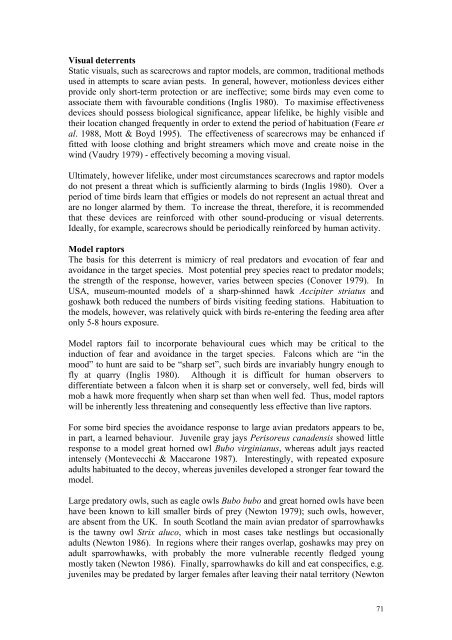RACING PIGEONS â IMPACT OF RAPTOR PREDATION
RACING PIGEONS â IMPACT OF RAPTOR PREDATION
RACING PIGEONS â IMPACT OF RAPTOR PREDATION
Create successful ePaper yourself
Turn your PDF publications into a flip-book with our unique Google optimized e-Paper software.
Visual deterrents<br />
Static visuals, such as scarecrows and raptor models, are common, traditional methods<br />
used in attempts to scare avian pests. In general, however, motionless devices either<br />
provide only short-term protection or are ineffective; some birds may even come to<br />
associate them with favourable conditions (Inglis 1980). To maximise effectiveness<br />
devices should possess biological significance, appear lifelike, be highly visible and<br />
their location changed frequently in order to extend the period of habituation (Feare et<br />
al. 1988, Mott & Boyd 1995). The effectiveness of scarecrows may be enhanced if<br />
fitted with loose clothing and bright streamers which move and create noise in the<br />
wind (Vaudry 1979) - effectively becoming a moving visual.<br />
Ultimately, however lifelike, under most circumstances scarecrows and raptor models<br />
do not present a threat which is sufficiently alarming to birds (Inglis 1980). Over a<br />
period of time birds learn that effigies or models do not represent an actual threat and<br />
are no longer alarmed by them. To increase the threat, therefore, it is recommended<br />
that these devices are reinforced with other sound-producing or visual deterrents.<br />
Ideally, for example, scarecrows should be periodically reinforced by human activity.<br />
Model raptors<br />
The basis for this deterrent is mimicry of real predators and evocation of fear and<br />
avoidance in the target species. Most potential prey species react to predator models;<br />
the strength of the response, however, varies between species (Conover 1979). In<br />
USA, museum-mounted models of a sharp-shinned hawk Accipiter striatus and<br />
goshawk both reduced the numbers of birds visiting feeding stations. Habituation to<br />
the models, however, was relatively quick with birds re-entering the feeding area after<br />
only 5-8 hours exposure.<br />
Model raptors fail to incorporate behavioural cues which may be critical to the<br />
induction of fear and avoidance in the target species. Falcons which are “in the<br />
mood” to hunt are said to be “sharp set”, such birds are invariably hungry enough to<br />
fly at quarry (Inglis 1980). Although it is difficult for human observers to<br />
differentiate between a falcon when it is sharp set or conversely, well fed, birds will<br />
mob a hawk more frequently when sharp set than when well fed. Thus, model raptors<br />
will be inherently less threatening and consequently less effective than live raptors.<br />
For some bird species the avoidance response to large avian predators appears to be,<br />
in part, a learned behaviour. Juvenile gray jays Perisoreus canadensis showed little<br />
response to a model great horned owl Bubo virginianus, whereas adult jays reacted<br />
intensely (Montevecchi & Maccarone 1987). Interestingly, with repeated exposure<br />
adults habituated to the decoy, whereas juveniles developed a stronger fear toward the<br />
model.<br />
Large predatory owls, such as eagle owls Bubo bubo and great horned owls have been<br />
have been known to kill smaller birds of prey (Newton 1979); such owls, however,<br />
are absent from the UK. In south Scotland the main avian predator of sparrowhawks<br />
is the tawny owl Strix aluco, which in most cases take nestlings but occasionally<br />
adults (Newton 1986). In regions where their ranges overlap, goshawks may prey on<br />
adult sparrowhawks, with probably the more vulnerable recently fledged young<br />
mostly taken (Newton 1986). Finally, sparrowhawks do kill and eat conspecifics, e.g.<br />
juveniles may be predated by larger females after leaving their natal territory (Newton<br />
71
















